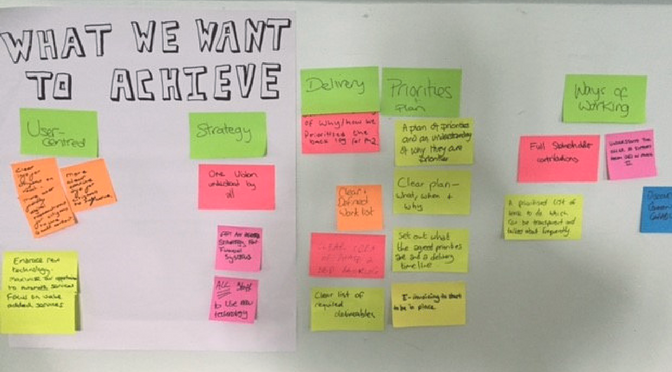Over the last six months at Stockport we’ve been thinking more and more about the potential of creating more structure and support for design-led transformation and improvement. This isn’t about Digital by Design, it is bigger than that. And nor is it just about reform, transformation or Service design specialists.
We recognise we are already doing service design, we do it all the time and we have shining examples of good practice. We feel though that we can share the learning and skills better as a whole organisation. We can do better to connect the dots, to go faster, with more consistency. This is why we are thinking more purposefully about our approach across the organisation and with our partners too.
But what is service design? Isn’t it about the user? “That’s user experience (UX)” I hear people say. Or business analysis? “That’s what we do.” I hear from others. Like UX, service-design needs to be based on understanding as best we can user needs, but Service Design is unique in its scope. It seeks to use Design Thinking tools and processes to maintain a focus on the wider context of the User Journey, rather than the experience of the technology.
It does overlap with both UX and with Business Analysis. With Business Analysis the overlap is sometimes so large that it seems indistinguishable. It certainly uses analytical and research skills. However, the focus on user research tools and skills and the impact of focusing on the full journey separate the work from many business analyst roles that are closely linked to delivery teams and are often technically focused or focused on business needs of economy and efficiency over user needs.
In truth the job roles are fuzzy. These roles like many others are interrelated and give us valuable perspectives which need to work in harmony to produce the best service delivery by balancing technical, organisational and user needs. It’s a challenging job, but we’re doing the hard work to make service delivery and experience simple.
Over a year ago we gathered together people who were doing this sort of work, we talked and pulled together some existing in-house good practice and augmented it with best practice from elsewhere. This forms the service design tool kit.
This toolkit aims to cover 4 areas of change. Each subject has a pdf which can be downloaded by clicking the links below:
Over the next few months we will be bringing in additional support to help us look at how we can develop our service design capability, not just through new roles (although we may decide these are of value), but through embedding design-thinking into the heart of the organisation so that all decisions seek to balance different needs and champion the user.
We will look at how in Stockport we can best design an approach which puts good design, continuous feedback and improvement at the heart of it, coordinates all the different roles and creates the capacity and capabilities to make the most of our resources and skills.
Design Thinking is everyone’s job, as is designing the services and processes. We’d like to be open and inclusive in this process and will start a dedicated blog on which we will post our activity, progress, challenges and outputs. We are starting small, piloting and testing, learning throughout. We are looking forward to working more widely with people across the organisation and connecting more with users over the coming months. We hope you do too.

